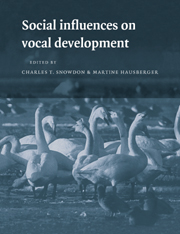Book contents
- Frontmatter
- Contents
- List of contributor
- 1 Introduction
- 2 Social interaction and sensitive phases for song learning: A critical review
- 3 Social interaction and vocal development in birds
- 4 Building a social agenda for the study of bird song
- 5 Field observations, experimental design, and the time and place of learning bird songs
- 6 Vocal learning in wild and domesticated zebra finches: Signature cues for kin recognition or epiphenomena?
- 7 What birds with complex social relationships can tell us about vocal learning: Vocal sharing in avian groups
- 8 Social influences on song acquisition and sharing in the European starling (Sturnus vulgaris)
- 9 Social influences on the acquisition of human-based codes in parrots and nonhuman primates
- 10 Vocal learning in captive bottlenose dolphins: A comparison with humans and nonhuman animals
- 11 Vocal learning in cetaceans
- 12 Social influences on vocal development in New World primates
- 13 Some general features of vocal development in nonhuman primates
- 14 Social influences on vocal learning in human and nonhuman primates
- 15 The resilience of language in humans
- 16 Reciprocal interactions and the development of communication and language between parents and children
- 17 Crafting activities: Building social organization through language in girls' and boys' groups
- Index
3 - Social interaction and vocal development in birds
Published online by Cambridge University Press: 04 August 2010
- Frontmatter
- Contents
- List of contributor
- 1 Introduction
- 2 Social interaction and sensitive phases for song learning: A critical review
- 3 Social interaction and vocal development in birds
- 4 Building a social agenda for the study of bird song
- 5 Field observations, experimental design, and the time and place of learning bird songs
- 6 Vocal learning in wild and domesticated zebra finches: Signature cues for kin recognition or epiphenomena?
- 7 What birds with complex social relationships can tell us about vocal learning: Vocal sharing in avian groups
- 8 Social influences on song acquisition and sharing in the European starling (Sturnus vulgaris)
- 9 Social influences on the acquisition of human-based codes in parrots and nonhuman primates
- 10 Vocal learning in captive bottlenose dolphins: A comparison with humans and nonhuman animals
- 11 Vocal learning in cetaceans
- 12 Social influences on vocal development in New World primates
- 13 Some general features of vocal development in nonhuman primates
- 14 Social influences on vocal learning in human and nonhuman primates
- 15 The resilience of language in humans
- 16 Reciprocal interactions and the development of communication and language between parents and children
- 17 Crafting activities: Building social organization through language in girls' and boys' groups
- Index
Summary
INTRODUCTION
Experiments on song development have a long history dating from those performed by the Baron von Pernau with chaffinches (Fringilla coelebs), published in 1768 (Thielcke 1988). The Baron documented regional song dialects, showed that learning was restricted to a time window or “sensitive phase,” and demonstrated the bird's preference for learning songs of conspecifics over those of allospecifics or “stimulus filtering.” With the advent of instrumentation that allowed capture and analyses of sound, i.e., magnetic tape-recording and sound spectrographic technology, Thorpe (1958) was able to test these conclusions objectively. He played tape-recorded conspecific and allospecific songs to hand-raised, naive chaffinches reared in acoustic isolation. His experiments confirmed the existence of sensitive phases and stimulus filtering mechanisms during the song-learning process.
Thorpe's study set a standard for avian song ontogeny protocol: hand-raised naive experimental or pupil birds are isolated in sound-proof chambers and exposed to taperecorded vocalizations of model or tutor birds. An investigator is then able to: (a) control the number of songs played to the experimental birds to determine the minimum number of songs required to effect learning (Petrinovich 1985; Hultsch & Todt 1992; Peters et al. 1992; Hultsch 1993); (b) demonstrate that birds may recognize conspecific song by sound alone (Konishi 1985); and (c) test the effect of sound degradation on the choice of tutors by pupils (Morton et al. 1986).
That social factors could influence the choice of a song tutor by a pupil was first appreciated by Nicolai (1959). His work suggested that tape-tutoring experiments, although valuable, may in some cases test only what pupils can do under the conditions imposed by the investigator and not the pupil's actual or potential capabilities in nature.
- Type
- Chapter
- Information
- Social Influences on Vocal Development , pp. 23 - 40Publisher: Cambridge University PressPrint publication year: 1997
- 39
- Cited by

